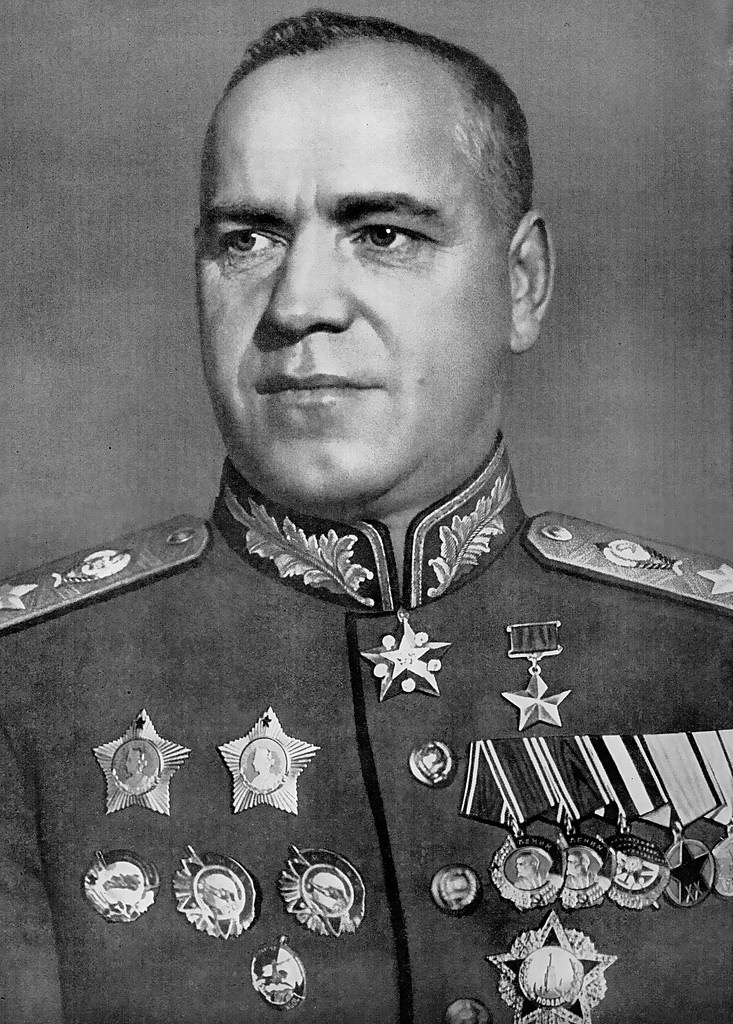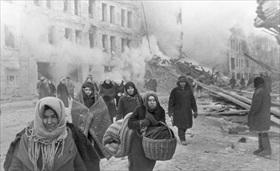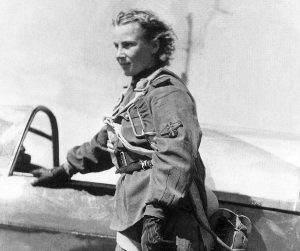Last week in Second World War history
Those who know their history know that the Eastern Front was by far the largest theatre of operations during the Second World War. The Soviet Union put more men and women into the fighting than all other Allies combined, and the countries of the Eastern Theatre suffered over 11 million casualties.
The Germans also put far more men and resources into the Eastern Front. The launch of the war in the east, Operation Barbarossa, sent nearly 4 million men across the Polish frontier, overwhelming—at first—a Soviet strength of under 3 million.

In comparison, the western Allies sent 1.3 million men into Italy between 1942 and 1945, and 156,000 stormed the Normandy beaches on D-Day.
On Facebook and Google+, I’ve been posting daily updates on “on this day in the history of the Eastern Front of the Second World War.” And here, I’ll post a summary of the previous week in history, three-quarters of a century ago.
September 25 – October 1
1939:
September 25:
- Hitler arrives in Poland to observe the bombing in Warsaw.
- Soviet troops capture Bialystock, Poland.
- Stalin proposes to Germany that the USSR take over Lithuania, giving Germany areas near Warsaw in exchange.
September 26:
-

Insignia of the Polish Home Army, Armia Krajowa. The resistance Polish Home Army, Armia Krajowa, established in Warsaw.
September 27:
- Polish government in exile sets up in Paris, France.
- After a 2-week siege, Warsaw falls to Germans.
- Soviets execute 150 Polish policemen.
September 28:
- Estonia and USSR sign a 10-year mutual assistance pact, allowing Soviet troops to be stationed in Estonia.
- Germans and Soviets sign agreement denoting common border in Poland.
-

Joachim von Ribbentrop, Reich Minister of Foreign Affairs. German Foreign Minister von Ribbentrop arrives in Moscow to announce joint Soviet-German negotiations for peace with Western powers.
September 29:
- Hitler orders repatriation of ethnic Germans living in Estonia and Latvia to Germany, as he knows the USSR will soon demand control of the Baltic States.
- Formal surrender of Poland and division between Germany and USSR
1940:
September 26:
- German ambassador to the USSR tells Soviets that Japan would join alliance with Germany and Italy.
October 1, 1940:
-

Erich Hartmann in 1944. Erich Hartmann, greatest fighter ace in the history of aerial warfare, begins basic training in East Prussia. He would shoot down 345 Soviet planes and never be shot down himself. After the war, he was wrongfully convicted of war crimes and served 10 years at hard labour in Soviet prisons. After his release, he joined the air force of the Federal Republic of Germany.
- Hitler orders Polish gentry exterminated and civilians’ living standards in Poland reduced, as they are now “workers” for the Reich.
1941:

Karl Jager, commander of Einsatzkommando Group A, a Nazi death squad, begins keeping detailed records of numbers of Jews and other civilians his team murdered each day. These became known as the “Jager Reports.” The Einsatzgruppen were special detachments of the SS, specifically charged with killing civilians. For example, during this week in 1941, he reports killing:
- September 25: 575 Jews in Lithuania
- September 27: 3,446
September 25:
- Hitler orders cease of attacks on Leningrad, in favour of starving the city.
- German and Romanian troops reach Perekop Isthmus to cut off Crimean Peninsula
September 26:
- German battleship Tirpitz joins naval manoeuvers in the Baltic Sea.
- Free French sign alliance with the USSR
September 27:
-

German truck stuck in the mud in Russia. Pinterest. Rain begins on the Eastern Front, making mud a problem for German invaders.
- Lord Beaverbrook and U.S. diplomat Averell Harriman arrive in Arkangelsk.
- 23,000 Jews murdered at Kamenets-Podolsk, Ukraine.
September 28:
- US and UK officials travel to Moscow to discuss western aid to USSR.
- Soviet General Gregory Zhukov announces that family members of captured Red Army soldiers would be arrested and shot.

Georgy Zhukov in 1944. Wikipedia. - Jews in Kyiv, Ukraine order to gather at Dorogozhitshay Street at 7:00 the next morning.
September 29, 1941:
- Reinhard Heydrich named Deputy Protector of Bohemia and Moravia.
- Vyacheslav Molotov, Lord Beaverbrook and U.S. representative Averell Harriman discuss Western aid to the USSR.
- Soviet submarine ShCh-319 attacks German ships off Latvia, then strikes a mine and sinks.
- Hitler orders Leningrad wiped out by bombardment.

Leningraders during the siege. Source: Daily Chronicles of World War II. - Einsatzgruppen death squads murder 50,000 – 96,000 Ukrainians at Babi Yar near Kyiv.
- Red Army prevents German forces from entering Crimea.
September 30, 1941:
- Military photographer and long-time Nazi Johannes Hahle turns over some photos in a folder marked “in the East” to his superiors, but keeps photos of the Babi Yar massacre a secret.
- Soviet Black Sea fleet begins considering transferring from Odessa to Crimea.
- German Operation Typhoon begins with early assault on Moscow.
October 1, 1941:
- US-UK-USSR aid conference produces protocol for immediate, long-term aid deliveries to the USSR.
- Finnish troops reach Petrozavodsk, capital of Soviet Karelia, further isolating Leningrad.
- Majdanek Concentration Camp in Poland begins operations.
- Soviets release over 50,000 Polish POWs to form a Polish unit of the Red Army to fight Germany.
-

Soviet POWs in 1941. Germans launch Operation Typhoon, attack on Moscow.
- Panzergruppe 2 splits into two to advance on Orel and Bryansk, Russia.
1942:
September 25:
- Hitler sacks Colonel-General Halder as Chief of the Army General Staff and replaces him with General Zeitzler
September 26:
-

Soviet ace Lydia Lytvyak, the first female ace. She made as many as 14 kills. Red Army launches offensive in Tuapse region in the Caucasus.
- German forces begin new offensive in Stalingrad.
- Soviet ace Lydia Litvyak shoots down German bomber over Stalingrad, and shares credit for downing a second.
September 27:
- Sgt. Jacob Pavlov and three other Soviet soldiers attack an apartment block in Stalingrad with hand grenades, expelling occupying Germans and freeing wounded Soviet soldiers. This building became the iconic “Pavlov’s House.” The men defended it for 58 days against infantry, artillery and tank attacks.

“Pavlov’s House” in Stalingrad, where a handful of men under Sgt. Jabo Pavlov defended the building against repeated attacks for two months.
September 29, 1942:
- Sigmund Freud’s sister Esther Adolphine dies in Theresienstadt concentration camp in occupied Czechoslovakia.
September 30, 1942:
- Soviet forces cross the Volga River near Moscow.
- Due to a typhus epidemic in the Auschwitz Concentration Camp, Commandant Rudoph Hoss forbids guards from consuming any raw foods.
- 610 Jews arrive at Auschwitz from the Netherlands. 454 gassed immediately.
1943
September 25:
- Red Army captures Roslavl and Smolensk.
September 27:
- German forces in Ukraine begin withdrawal to western bank of Dnipro River.

An iconic war photo of the Red Army preparing to cross the Dnipro River in 1943, chasing the retreating Germans. From Bill Downs, War Correspondent. - Red Army captures Temryuk, Russia, the last Black Sea port held by Germans.
September 28:
- Germans recapture Split, Yugoslavia from partisans
September 28:
- Minesweeper USS Aspire transferred to the USSR under the lend-lease agreements.
September 30, 1943:
- Red Army expands is bridgehead over the Dnipro River in southern Ukraine to 500 km.
- U-boat “wolfpack” in the Kara Sea north of Russia sink freighter Arhangelsk.
October 1, 1943:
-

German U-boat, circa 1942. Pinterest. German u-boats sink Soviet freighter and escort ship in the Kara Sea, off northern Russia.
1944:
September 25:
- Soviets trick Slovakian Captain Frantisek Urban to visit Moscow, then arrest him, sending him to Lubyanka Prison.
September 26:
- Red Army completes occupation of Estonia.
September 27:
- 2000 soldiers of Armia Krajowa, Poland’s resistance army, surrender in Warsaw
September 28:
- Germans begin transferring 18,000 prisoners from Theresienstadt Concentration Camp, Czechoslovakia to Auschwitz Concentration Camp, Poland.
- Josip Tito authorizes Soviet troops to enter Yugoslavia. Red 57th Army begins moving toward Belgrade.
September 29:
- US OSS agents parachute into Bucharest to liberate 1,888 Allied POWs, and take Romanian diplomatic documents to prevent their capture by Soviets.
October 1, 1944:
- Slovak resistance fighters name themselves the Czechoslovakian 1st Army.
- Hungarian delegation comes to Moscow to discuss armistice separate from Germany.
- Red Army crosses Danube into Yugoslavia.
October 2, 1944:
-

Boy Scouts in the Armija Krajowa, the Polish Home Army, during the Warsaw Uprising. Wikimedia Commons. Warsaw Uprising ends after 63 unsuccessful days of fighting. 15,200 Armia Krajowa insurgents and 200,000 civilians killed, along with 16,000 German forces.
This is the history that I cover in the Eastern Front trilogy, through the eyes of a man who was there: my father-in-law, the late Maurice Bury.
Check out the books from their page on this website, or on Amazon.
Have anything to add about last week in history? Leave a Comment!
